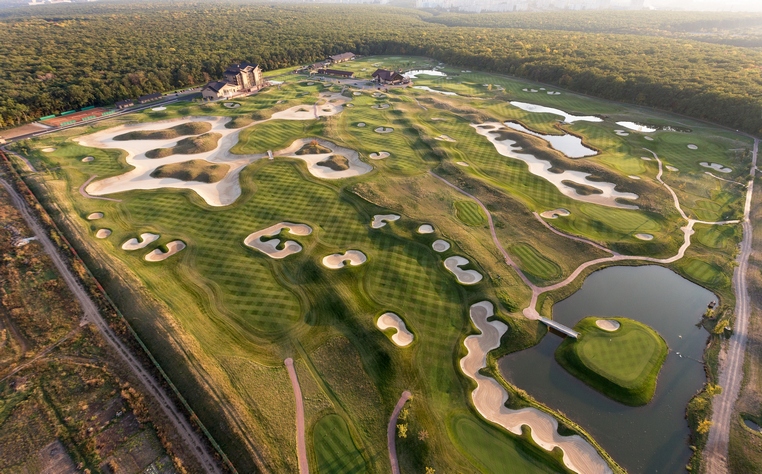Golf architect Edwin Roald discusses how high-tech ranges can displace traditional ranges, revolutionize land use and attract a new generation to the game.
“That’s what we’ve always done.” These five words that cement the established order of things have long been recognized as the most expensive words in business. In the business of golf, however, they carry little weight and are often untrue. If Darwin had looked at golf’s 600-year history and the significant changes in the game during that time in terms of evolution, he probably would have equated them with mutations.
These mutations or leaps could include the advent of metal jacks shortly after the end of World War I. Metal hubs, in turn, gave rise to club sets with extremely similar characteristics. Previously (and for some time after) hockey hockey blades were made of special wood, and each hockey club was unique. Each had a unique flexibility characteristics, and the bending moment was much more noticeable than in modern models. More importantly, the old wooden carpets were too brittle to permit the regular, intensive practice of long kicks that we have become accustomed to these days. As a result, very few fields created before the advent of steel hubs had areas even remotely resembling modern driving ranges.
As steel halves became more popular, more and more land became available for driving ranges. Today they have become an important component in the design of golf courses. However, the creation of a driving range requires a large area: a good driving range occupies about twelve acres (five hectares). In addition, it can have a significant impact on the layout of the clubhouse – on where the clubhouse will be located, on what the routes of travel around the clubhouse and the course will be.
That’s why rangeways often require some sacrifice in the field design process.
Some can’t always be immediately evaluated or measured. Some, on the other hand, can be estimated quite easily. Equipment costs, man-hours spent collecting and recovering practice balls, ball attrition, damage and depreciation, replacement and improvement of synthetic turf and other equipment, maintenance of ball dispensers, ball washing, electricity, lighting, cost of laying, mowing and other ground maintenance: fertilization, irrigation and application of various chemicals.
All of the above lead to significant economic and environmental costs. Is there an alternative?
Golf simulators have gotten much better in recent years. Their use is gaining popularity and many coaches consider them almost a mandatory part of the training process at the highest level. It is natural to assume that in the future simulators will improve, become more accessible and user friendly, while increasing their compatibility with cell phones and digital devices.
It is natural to assume that in the future there will be a steady increase in competition for land and other resources, which will manifest itself in a constant rise in prices. Golf is a major land user and is slow to respond to such changes in the world around it. The significant and proactive effect of golf in terms of social and environmental components has now lost its former importance. And in this respect, simulators offer and provide a unique opportunity for golf.
If there is a high demand for land, practice areas can be used for new purposes and part of them can be used to accommodate simulators. This measure will allow golfers to practice or warm-up in comfortable conditions throughout the year and allow the club to increase profitability in the off-season. Regardless of climatic conditions, such indoor workouts avoid exposure to unnecessarily hot or cold temperatures, while the usual driving ranges often risk possible profits due to short-term availability of facilities or adverse weather conditions that significantly affect golfers’ cravings for the game.
Simulators also provide the opportunity for virtual play, where the player battles the best golfers or tries to outplay opponents from around the world in online tournaments. Simulators can play a key role in securing golf’s future by introducing the game to a new generation – children and technically oriented users – who will enjoy themselves in their familiar video game mode.
Finally, simulators allow golfers to use the highest quality balls instead of practice balls with reduced performance, which not only fail to replicate the trajectory of a good ball, but also fly not as far at all. Compared to the visual analysis of a ball battling the elements within a driving range, the simulator provides accurate and immediate information on direction, range, trajectory, lateral and backspin, club head speed, and swing line. These factors can be used by the golfer to track his progress. This can save considerable time and effort, allowing for much faster progression by applying the precise instructions received.
When considering these technological advantages against the above-mentioned economic and environmental trends, it seems that traditional driving ranges are slowly becoming a thing of the past.
Nevertheless, they are unlikely to disappear completely. Rationally located urban facilities may well retain their niche. In addition, competitions at the highest level will still require that the sports elite can prepare, train and have the opportunity to visualize the ball’s flight and trajectory when hitting from natural ground. For example, The Open Championship majors are often played on golf courses that predate the advent of steel clubs. Temporary practice facilities are therefore sometimes set up on suitable adjacent areas with good soil or on the fairways of nearby courses with similar characteristics. Tournament venues interested in eliminating the maintenance of driving ranges can act in a similar fashion in preparation for competitions.
Just as the introduction of steel hubs less than a century ago had a tangible effect, so technological advances will undoubtedly continue to sharpen the use of turf and other golf resources. The very idea of allocating, preparing and maintaining large and expensive areas used predominantly on a seasonal basis solely for hitting lower quality balls without receiving proper feedback is simply not capable of competing with today’s available and constantly evolving technology. This fact is evidence of the end of an entire era.